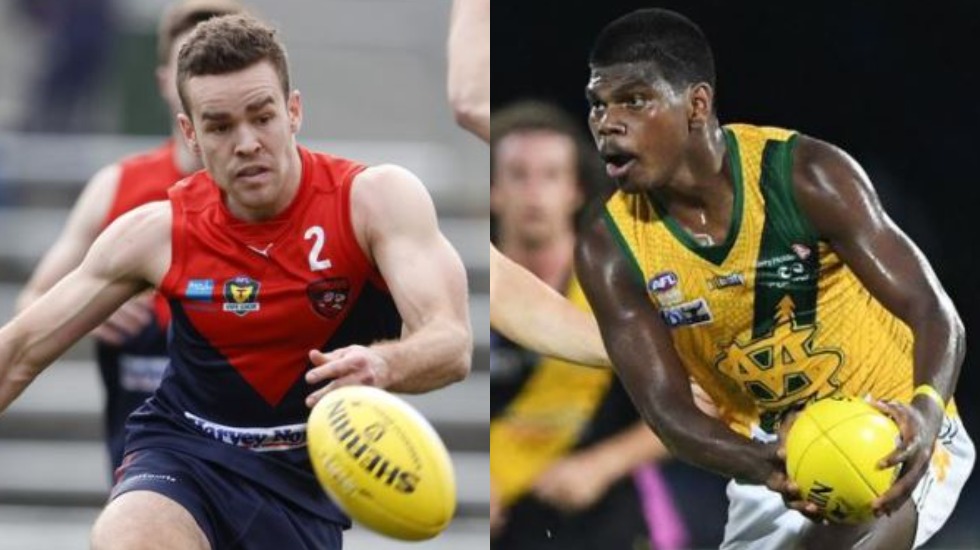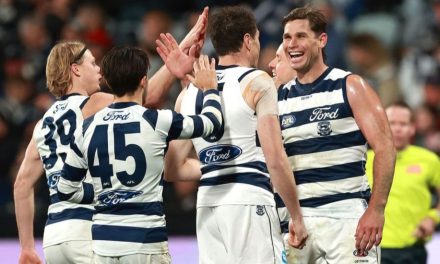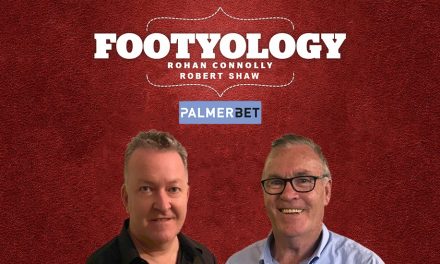(Left): North Hobart’s Hugh Williams in action in Tasmania. (Right): Richmond draftee Maurice Rioli Jnr. with St Mary’s in NT.
Any heat between the AFL and the Tasmanian Government has certainly gone up a few degrees after last week’s leaking of news the league may bankroll another season of “home” games for Hawthorn and North Melbourne in lieu of state government support.
Tasmanian Premier Peter Gutwein said it “beggared belief” the AFL had not been able to deliver a timeline of when the Apple Isle could expect to have a team of its own enter the competition.
And the potential ending of agreements with the Hawks and Roos at the end of this year be a clear statement that in its latest bid for an AFL club presence, after several previous fruitless attempts, Tasmania this time isn’t mucking around.
Is there, however, another potential element to this power play more or less flying under the radar? Along with a very real prospect of – within four or five years – a 20-team competition?
While the population of the Northern Territory is only around 245,000, an astonishing 53,000 of them play Australian Rules. That’s more than 21 per cent of the Territory’s population, about three times the participation rate in football’s spiritual home of Victoria. And if you thought Tasmania was the only government impatient for its own AFL team, you’re wrong.
Sources close to the NT State Government report a mood of cautious optimism that the Territory will have its own AFL team. And while the prospect of a big league team from a remote part of this country might surprise a few people, it probably shouldn’t.
While Tasmania remains in pole position for the AFL’s next franchise, the mathematics of the league’s contractual arrangements with television, radio and streaming broadcasters mean that – like previous expansion clubs Gold Coast (2011) and GWS (2012) – two new teams will likely get the nod.
Tasmania would get first dibs, with the NT a strong candidate for admission later because, put simply, 10 games per week is more lucrative than nine games and a bye. And new broadcasting rights agreements are due from season 2025.
The Territory faces competition from WA, a booming football state where there could be room for a third team. But the mood up north is that they’re well-placed, and overdue for a fair go.
A “scoping study” into the NT’s viability for an AFL team, commissioned in October 2018 at NT taxpayer expense, has not been released to the public, despite its having been tabled to the AFL NT board nearly 18 months ago.
But teasing the report’s contents, AFL NT chief executive Stuart Totham said that despite financial and corporate support concerns following the demise of the Territory’s NEAFL team, and a small population split between the Top End and the “Red Centre”, he was “very optimistic” about the prospect of a homegrown franchise.
“The report is pretty clear on what the challenges are,” he told the ABC, “but there are solutions also tabled in the report to help address those as well, so it’s a very positive report.”
That said, there’s serious frustration in Darwin political circles that the detail of the report isn’t more widely known.
“It keeps our moves for a team out of the public consciousness, and I’m wondering if that’s on purpose,” one source told Footyology. “It seems someone down south wants to slow it all down”.
It is understood the government is both impatient at the lack of progress on the scoping report but cautiously enthused by Tasmania’s bold moves for a team, which could have a flow-on effect.
“I understand that AFL NT will present that study in the first half of 2021,” Chief Minister Michael Gunner told the ABC. Both the government and AFL NT had previously expected the report to be released early last year.
Details of the potential NT club remain sketchy, but it would play in both Darwin and Alice Springs, where the AFL has been hosting premiership season matches now for more than a decade,
Territory stars drafted to outside clubs could return home as “franchise players”, leading to an estimated 20 or 25 home grown stars on the club’s list. The scoping report deals with the financial viability of a proposed club, the facility options available, and a possible upgrade of TIO Stadium in the Darwin suburb of Marrara.
Gunner said it was important the NT was prepared for the opportunity to win a club license from the AFL. “I’ve said before that I love the idea of establishing an AFL side here in Darwin,” he said. “But we are also realistic that it could be some years before a license becomes available”.
Meanwhile, impetus for a Tasmanian AFL team is building serious momentum, the state government having adopted a “crash through or crash” approach, putting negotiations on hold for Hawthorn and North Melbourne’s “home” games there until the AFL delivers a timeline for a new team. Both sides are on a tight timeframe: agreements for those eight “home” games expire next year.
PLEASE HELP US CONTINUE TO THRIVE BY BECOMING AN OFFICIAL FOOTYOLOGY PATRON. JUST CLICK THIS LINK.
It’s a bold poker move with the potential to alienate decision-makers in Melbourne, but the Premier appears to have a strong hand.
If the AFL calls Gutwein’s bluff, Tasmania could be left with no AFL games at all, but if he’s not bluffing, Hawthorn and North Melbourne might be forced to play unprofitable home games against Fremantle or GWS before half-empty stadiums (COVID crowd restrictions or not) in Melbourne, with massive impacts on their bottom line.
Well-worn arguments against a Tasmanian AFL team were addressed and thoroughly rebutted by respected economist and University of Tasmania graduate, Saul Eslake, in 2008. So assiduous was the doomed Tasmanian bid of that year that even a sceptical Andrew Demetriou admitted it “ticked all the boxes”.
The NT might have Australia’s highest football participation rate, but Tasmania comes in second, and has produced more than its share of the game’s champions, from Royce Hart to Darrel Baldock, Laurie Nash to Ian Stewart. If there’s a state that deserves “co-founding” Australian Rules status alongside Victoria, it’s Tasmania.
And while the potential loss of AFL games would be devastating to Tasmanians, in a very real sense the Apple Isle has nothing to lose long term.
Last year’s report into whether a Tasmanian team should be granted an AFL license warned that inaction would lead to Australian Rules football withering on the vine as other sports grew.
“Football has enjoyed a rich history in Tasmania, playing an integral part in its communities and contributing to the national game. Yet the game is under threat – stagnating at best,” the report said. “Local support and interest for both Hawthorn and North Melbourne has eroded over the past decade, and value will likely follow”.
While there’s arguably nothing to lose from the Tasmanian Government perspective, the report says there’s plenty to gain from its current strategy.
“Independent modelling of the direct economic impact of 11 home games (for a Tasmanian AFL team) … indicates a direct contribution to the state of more than $110 million per annum and hundreds of jobs”.
Taking the initiative as Gutwein did was a “no-brainer”. It was bound to set the cat among the pigeons, and sure enough, within hours of the leaking of his ultimatum to the AFL, Hawthorn president Jeff Kennett put his legendary foot in his mouth, refusing to rule out a relocation for his club and its 76,343 mostly Melbourne-based members.
Club great Don Scott immediately slammed Kennett’s statement as an insult to Hawthorn’s board and fans. “The reaction would be very loud if they were going to do something like that,” Scott told The Age. He ought to know, having led a successful campaign against a club merger in 1996.
Of course, Tasmania might have hosted the 18th club as early as 2012 but for the league venturing into territory described by sceptics as “the AFL’s Vietnam” with Greater Western Sydney.
As it poured resources into western Sydney, the AFL jeopardised goodwill in regions where participation rates and community interest had always been high. Indeed, Tasmania’s 2008 AFL bid was treated with contempt by then-chief executive Demetriou, who clearly wanted to go another way.
“I’ve never seen anyone speak to a Premier like he [Demetriou] spoke to ours,” former Tasmanian economic development minister Paula Wriedt told The Age. ”[It was] to the point of actual bad manners”.
Tasmanians aren’t stupid. They know they’re being used to prop up a couple of clubs who aren’t their own, and never will be. For a massive investment of hard-earned tax dollars, they’ve been assigned fixtures between fly-in, fly-out “home” teams and hardly compelling opposition like Gold Coast. It’s not sustainable, with crowds down and participation tanking.
Likewise, the number of draftees from the NT is dwindling: from 27 players in 2012 to just 11 last year. “It’s hard to say it’s cyclic because of the time frame, eight years,” Totham said.
The NT’s AFL license proposal is expected to include a major boost to player development infrastructure, which is currently split between local clubs and AFL club Next Generation Academies, whose talent output has been spasmodic.
Importantly, a new NT club would have its own purpose-designed Northern Academy, with first dibs on local talent so players can be nurtured in a culturally-tailored local environment where they won’t get homesick. The potential NT talent pool boasts both quality and quantity.
The AFL’s Australia-wide expansion was as inevitable as it was necessary. There are national competitions in cricket, soccer, netball, baseball and basketball, and semi-national competitions in rugby union and league. Had football failed to at least have a crack at hitherto barren markets like western Sydney, it might have been left behind.
That said, there’s no need to leave the game’s grassroots behind. And while 12 teams, a final four and lace-up guernseys might be a thing of the past, there’s a silver lining for traditionalists in the prospect of home-grown teams from Tasmania and the NT, yes, even for fans of several Victorian clubs.
Take supporters of Melbourne, North Melbourne and Hawthorn, for example, all of whom have watched their teams play “home” games far from home in the modern era, but in a competition further expanded, would get to see them in the flesh more often at genuine homes.
The claims of Tasmania and the NT are gathering momentum to the point this is no longer a pipe dream. Perhaps it might even be one of the increasingly rare scenarios in the modern world, where everyone really can win.












If we had a 20 team competition, what about a 19 round season with a final eight? The fixture would then be set for two seasons (the following season just the opposite fixture the following year (e.g. Tassie V NT in Launceston one year, NT v Tassie in Darwin in the corresponding round a year later) It would lead to a fair competition where everyone plays everyone else once a year, whilst the finals would reward excellence, rather than reward a mediocre team with finals, as is the case currently. 190 games in the H&A fixture is about the same as we have currently, so no loss over 19 rounds as opposed to the current 23.